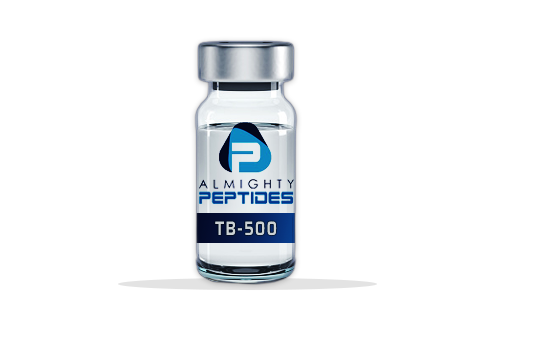About for TB4 and TB-500
BUY THYMOSIN BETA 4 / TB-500 5MG PEPTIDE
TB-500 and TB4, also known as Thymosin Beta-4, are peptides that have gained popularity in the world of sports and fitness due to their potential therapeutic and performance-enhancing properties. While they share similarities in their structure and function, there are also important differences between the two. In this comprehensive overview, we will explore the similarities and differences between TB-500 and TB4, including their structures, functions, potential applications, and current research findings.
Structure and Composition
TB-500 and TB4 are both synthetic versions of naturally occurring peptides found in the human body.
Thymosin Beta-4 (TB4) is a naturally occurring 43-amino acid peptide that is encoded by the TMSB4X gene in humans.
TB-500 5mg, on the other hand, is a synthetic peptide that is structurally similar to TB4 but is a shorter fragment consisting of 17 amino acids.
TB4 consists of a unique G-actin sequestering peptide, which means it plays a role in regulating actin, a protein that is essential for cell structure and movement.
TB4 has been shown to be involved in a wide range of cellular processes, including cell migration, differentiation, and tissue repair.
TB-500 5mg, being a synthetic peptide, is designed to mimic the effects of TB4, particularly in promoting healing and tissue repair.
Mechanism of Action
Both TB-500 and TB4 5mg are known for their regenerative and healing properties. They work by promoting cellular migration, proliferation, and differentiation, which are crucial processes in tissue repair and wound healing. These peptides also have anti-inflammatory effects, which can further contribute to their therapeutic potential.
TB4's mechanism of action involves its ability to interact with actin and other cellular components to regulate cell structure and function. It has been shown to promote the migration of endothelial cells, which are essential for the formation of new blood vessels (angiogenesis) and tissue repair. Additionally, TB4 has been found to modulate inflammation and reduce tissue damage in various injury models.
TB-500 5mg exerts its effects through similar mechanisms, promoting cell migration and proliferation to facilitate tissue repair. It has been shown to enhance the production of extracellular matrix proteins, such as collagen, which are essential for tissue regeneration. Furthermore, TB-500 has demonstrated anti-inflammatory properties, which can aid in reducing tissue damage and promoting recovery.
Potential Applications
Due to their regenerative and healing properties, TB-500 and TB4 5mg have garnered interest for a wide range of potential applications, including in the fields of sports medicine, veterinary medicine, and regenerative medicine. These peptides have been investigated for their potential to accelerate healing in various tissues, including muscle, tendon, ligament, and cardiac tissue.
In sports and fitness, TB-500 and TB4 5mg have gained attention for their potential to promote recovery from injuries, reduce inflammation, and support tissue repair. Athletes and fitness enthusiasts may use these peptides to aid in the recovery from intense training, as well as to address injuries such as muscle strains or ligament sprains.
In veterinary medicine, TB-500 and TB4 5mg have been explored for their potential to promote healing in horses and other animals. Equine athletes, in particular, may benefit from the regenerative effects of these peptides in the treatment of musculoskeletal injuries.
In regenerative medicine, TB-500 and TB4 are being studied for their potential to aid in the repair of various tissues and injuries, including those affecting the musculoskeletal system, skin, and cardiac tissue. Researchers are investigating the use of these peptides in tissue engineering and regenerative therapies to promote the repair and regeneration of damaged or diseased tissues.
Research and Clinical Studies
Both TB-500 and TB4 have been the subject of numerous preclinical studies exploring their effects on tissue repair and regeneration. These studies have investigated the peptides' potential to promote healing in various contexts, including muscle injuries, wound healing, and heart repair.
In a study published in the Journal of Orthopaedic Research, researchers found that TB-500 treatment promoted the healing of skeletal muscle injuries in rats. The peptide was shown to enhance the formation of new blood vessels in the injured muscle, as well as the production of collagen, a key component of connective tissue. These findings suggest that TB-500 may have applications in the treatment of muscle injuries in humans.
Similarly, studies on TB4 have demonstrated its potential in promoting tissue repair. Research published in the Annals of the New York Academy of Sciences has shown that TB4 treatment can enhance the healing of skin wounds by promoting the migration and proliferation of skin cells. Additionally, TB4 has shown promise in promoting cardiac repair following heart attacks in animal models.
While much of the research on TB-500 and TB4 has been conducted in preclinical settings, there is growing interest in exploring the clinical potential of these peptides. Clinical trials are needed to further evaluate the safety and efficacy of these peptides in humans across a range of therapeutic applications.
Similarities and Differences
While TB-500 and TB4 share many similarities in terms of their regenerative and healing properties, there are important differences between the two peptides. The most significant difference lies in their molecular structures, with TB-500 being a shorter peptide fragment derived from the larger TB4 molecule. This structural difference may impact their interactions with cellular receptors and binding proteins, potentially leading to variations in their biological effects.
In terms of their potential applications, both peptides have shown promise in promoting tissue repair and regeneration, reducing inflammation, and supporting healing processes. However, due to their structural differences, they may exhibit nuanced differences in their specific effects on different tissues and cell types.
From a practical standpoint, TB-500 is often favored for its stability and ease of use, as it can be stored in a lyophilized (freeze-dried) form and reconstituted with sterile water for injection. TB4, being a larger and more complex molecule, may present challenges in terms of stability and formulation for therapeutic use.
Regulatory Considerations and Ethical Concerns
It is important to note that the use of TB-500 and TB4 other peptide-based therapies is subject to regulatory oversight in many jurisdictions. In some countries, these peptides may be classified as prescription medications, and their use may be restricted to specific medical indications under the supervision of a qualified healthcare professional.
Additionally, ethical considerations surround the use of peptide-based therapies in sports and fitness settings. While these peptides may offer potential benefits in supporting recovery and healing, their use by athletes for performance enhancement purposes may raise ethical questions, particularly in competitive sports.
Conclusion
In conclusion, TB-500 and TB4 are peptides with regenerative and healing properties that have garnered interest for their potential applications in sports medicine, veterinary medicine, and regenerative therapies. While they share similarities in their mechanisms of action and potential applications, there are important differences in their structures and potential biological effects. These differences may influence their specific effects on tissues and their practical utility as therapeutic agents.
As research into these peptides continues, it is important to conduct further preclinical and clinical studies to better understand their safety and efficacy across various therapeutic applications.
Additionally, regulatory oversight and ethical considerations should guide the responsible development and use of these peptides in medical and performance-enhancing contexts.
Ultimately, while TB-500 and TB4 hold promise for promoting tissue repair and regeneration, their use should be approached with caution, and individuals considering their use should consult with qualified healthcare professionals to weigh the potential benefits and risks in their specific situations.
As with any emerging therapeutic agent, ongoing research and clinical investigation will be crucial in elucidating the full potential of TB-500 and TB4, as well as in determining their optimal applications and guidelines for safe and responsible use.
Free Shipping
Free delivery over $200
safe payment
100% Secure Payment
Online Discount
Add Multi-buy Discount
Help Center
Dedicated 24/7 Support
Fast delivery
100% Secure delivery



